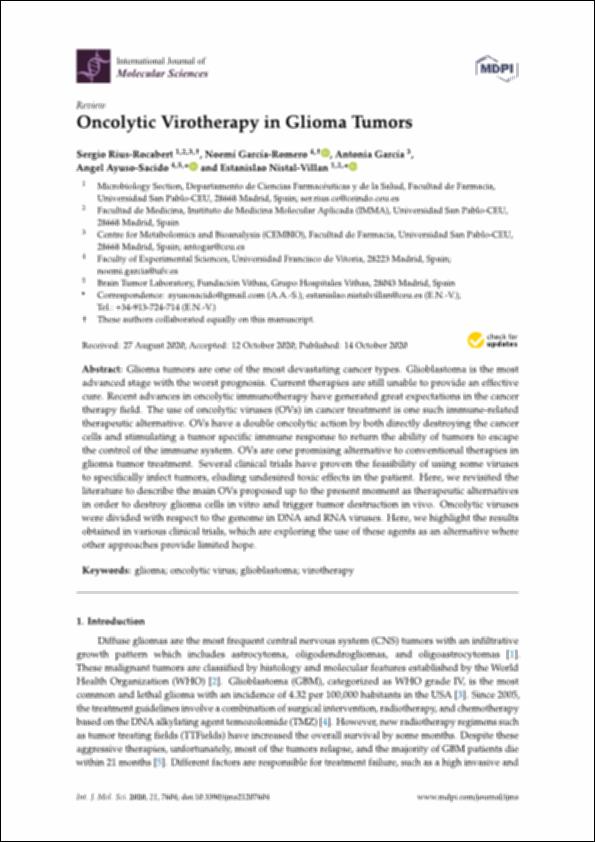Por favor, use este identificador para citar o enlazar este ítem:
http://hdl.handle.net/10637/15304Oncolytic virotherapy in glioma tumors
| Título : | Oncolytic virotherapy in glioma tumors |
| Autor : | Rius Rocabert, Sergio García Romero, Noemí García Fernández, Antonia Nistal Villán, Estanislao |
| Autor : | Universidad San Pablo-CEU. Facultad de Farmacia. Departamento de Ciencias Farmacéuticas y de la Salud |
| Materias: | Glioma; Oncolytic virus; Glioblastoma; Virotherapy |
| Editorial : | MDPI |
| Citación : | Rius-Rocabert, S., Garcia-Romero, N., Garcia, A., Ayuso-Sacido, A., & Nistal-Villan, E. (2020). Oncolytic Virotherapy in Glioma Tumors. INTERNATIONAL JOURNAL OF MOLECULAR SCIENCES, 21(20), 7604. https://doi.org/10.3390/ijms21207604 |
| Resumen : | Glioma tumors are one of the most devastating cancer types. Glioblastoma is the most advanced stage with the worst prognosis. Current therapies are still unable to provide an effective cure. Recent advances in oncolytic immunotherapy have generated great expectations in the cancer therapy field. The use of oncolytic viruses (OVs) in cancer treatment is one such immune-related therapeutic alternative. OVs have a double oncolytic action by both directly destroying the cancer cells and stimulating a tumor specific immune response to return the ability of tumors to escape the control of the immune system. OVs are one promising alternative to conventional therapies in glioma tumor treatment. Several clinical trials have proven the feasibility of using some viruses to specifically infect tumors, eluding undesired toxic effects in the patient. Here, we revisited the literature to describe the main OVs proposed up to the present moment as therapeutic alternatives in order to destroy glioma cells in vitro and trigger tumor destruction in vivo. Oncolytic viruses were divided with respect to the genome in DNA and RNA viruses. Here, we highlight the results obtained in various clinical trials, which are exploring the use of these agents as an alternative where other approaches provide limited hope. |
| URI : | http://hdl.handle.net/10637/15304 |
| Derechos: | http://creativecommons.org/licenses/by-nc-nd/4.0/deed.es |
| ISSN : | 1422-0067 |
| Fecha de publicación : | 2020 |
| Centro : | Universidad San Pablo-CEU |
| Aparece en las colecciones: | Facultad de Farmacia |
Los ítems de DSpace están protegidos por copyright, con todos los derechos reservados, a menos que se indique lo contrario.


